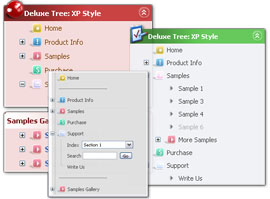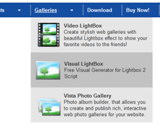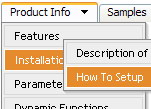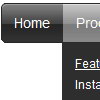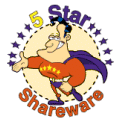Recent Questions
Q: Does your site navigation menu support RTL Pages? How hard it is to convert it this way?
A: var dmRTL = 0;
Set this parameter to 1 if you're using right-to-left direction of html page <HTML dir=rtl>.
Q: I am using JavaScript Deluxe Menu v3.1 and have some problem with the doctype declaration. If I use the declaration:
<!DOCTYPE html PUBLIC "-//W3C//DTD XHTML 1.0 Strict//EN" "http://www.w3.org/TR/xhtml1/DTD/xhtml1-strict.dtd">
the menuBackImage and itemBackImage images do not display properly. Check with and without doctype declaration. Is there a known fix for this?
A: You should specify units in "px" for the javascript menu object.
var itemPadding="15px 10px 0px 20px";
var menuStyles = [
["smColumns=2","itemPadding=25px 10px 10px 10px"],
["itemPadding=25px 10px 10px 20px"],
["menuBackImage=img/nahbp_1.gif","itemPadding=25px 10px 10px 20px"],
];
Q: Hi, I need to know if it is possible to accomplish the following functionalities with your tree-menu library.
1. I need to have two or more trees in the same page
2. I need to have a checkBox in each node and through a JavaScript function be able to add the selected nodes into another tree.
3. I need to eliminate the nodes that has check=true
4. I need to populate on-demand the tree using AJAX
5. I need to implement drag&drop through the use of the mouse events on the tree nodes
6. How would the tree behave with 10000 nodes??
7. I need to have a tree within another element that uses scroll
such as a DIV or SPAN (fixed area). When collapsed or expanded, the area should remain its original size.
A: 1. You can add any number of the menus on the one page.
2, 3, 5. Yes, you can do it. But you should create your own server-side script (for example, php) that will do it. The menu doesn't support such a feature.
4. Unfortunately, you can't use the AJAX-like technology in the Deluxe Tree such as in Deluxe Menu.
6. It is possible that the loading speed can be lower if the menu is very large. But it doesn't take so much time.
Yes, you can notice some delay in IE, but in over browsers it works better.
Deluxe Tree works fast, but 10000 is a large value. Please, try atrial version of Deluxe Tree.
I tried to create large menus on my machine: P4 3GHz, 512RAM WinXP SP2
It takes:
- 1000 items ~ 10 sec
- 2000 items ~ 40 sec
7. You can paste Deluxe Tree into the <table> or <div>.
Q: Only problem left is that we see an empty image in the left corner of the java pulldown menu.
I can't find how to remove this image. Do you know where this comes from?
A: You should delete the following string from your menuItems
["","", , , , , "0", ],
Try that.

